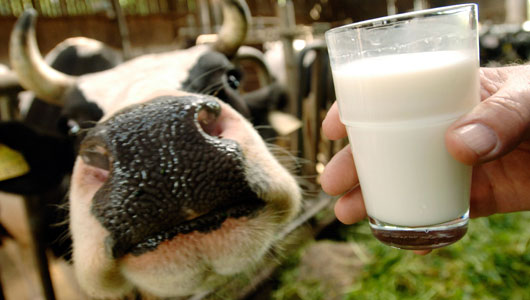In recent years, there’s been a crackdown on small dairies producing raw milk, designed as an obstacle to the growing legions of consumers demanding healthier and more flavorful milk. Raw milk has been deemed “unfit” for human consumption by the FDA and other government sting operations, and the public propagandized into fearing it. According to some fear-mongers, for example, raw milk causes rabies.
David Gumpert, author of popular blog The Complete Patient and forthcoming book Raw Milk Revolution: Behind America’s Emerging Battle Over Food Rights (Chelsea Green, Oct 2009), asks an important question: How much of the fear-mongering from the pro-pasteurization people is real, and how much is propaganda from Big Agribusiness? Gumpert says the anti-raw-milk campaign is just another governmental technique to sanitize the food supply—even in the face of ever-increasing rates of chronic disease like asthma, diabetes, and allergies.

Here are 10 things you should know about raw milk that the government won’t tell you:
1. Raw milk is healthier: Pasteurized milk is accused of causing everything from allergies to heart disease to cancer, but back in the day, these diseases were rare. In fact, clean raw milk from grass-fed cows is chock full of healthy amino acids and beneficial enzymes, and was used as a cure.2. Raw milk does not make you sick: That is, if it is properly collected from cows fed good, clean grass. Grass-fed milk has natural antibiotic properties that help protect it from pathogenic bacteria. But it’s worth noting, if you’ve been using pasteurized dairy products, you might want to eat small amounts of yogurt or kefir for a week or so, for a dose of probiotics, just to be safe. I did, and it helped.
3. Not all raw milk is the same: The cow’s diet, how and where it’s raised, and how the milk is collected are all factors in the safety and quality of raw milk. Cows pastured on organic green grass produce milk with good health benefits. It’s good to know where your milk is coming from.
4. Pasteurization was instituted in the 1920s to combat TB, infant diarrhea, undulant fever and other diseases caused by poor animal nutrition and dirty production methods. But modern stainless steel tanks, milking machines, refrigerated trucks, and inspection are enough of a precaution, and pasteurization has become irrelevant.
5. Pasteurization destroys enzymes, diminishes vitamin content, kills beneficial bacteria, promotes pathogens and is associated with allergies, increased tooth decay, colic in infants, growth problems in children, osteoporosis, arthritis, heart disease and cancer.

6. Calves fed pasteurized milk don’t do very well, and many die before maturity. Scary, considering the milk originally came from their mom.
7. Raw milk sours naturally but pasteurized milk turns putrid; processors must remove slime and pus from pasteurized milk by a process called centrifugal clarification. Gross.
8. Inspection of dairy herds for disease is not required for pasteurized milk. This means, pasteurization is used as a nifty way to wash away all forms of bad bacteria that are allowed to flourish freely before the process. Imagine that for a second.
9. Raw milk has more butterfat, which is rich in fatty acids that protect against disease and stimulate the immune system. Skim milk doesn’t necessarily mean it’s better for you, in other words.
10. Pasteurization laws favor large, industrialized dairy operations and push out small farmers. When farmers have the right to sell raw milk directly to their consumers, they can make a decent living even with a small number of cows. Support small farmers!
Source: http://www.undergroundhealth.com/10-things-you-should-know-about-raw-milk/
Post a Comment